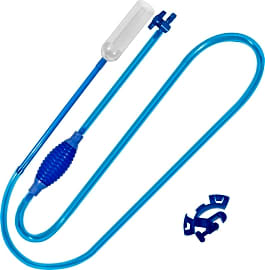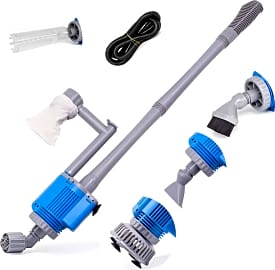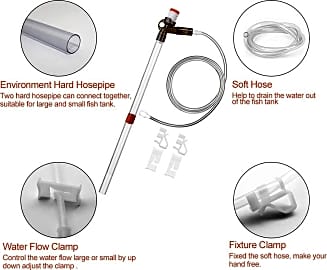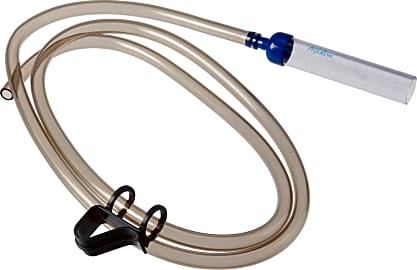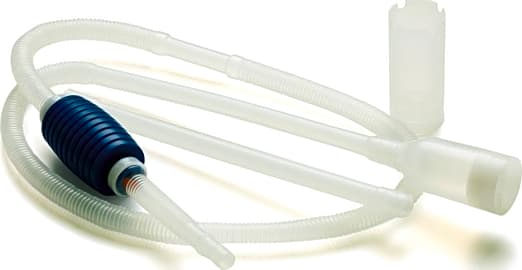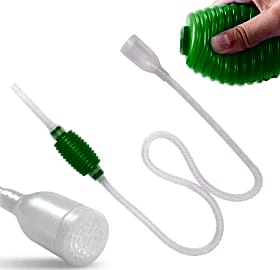The 8 Best Aquarium Gravel Cleaners

This wiki has been updated 34 times since it was first published in October of 2016. Whether you have a couple of goldfish or a multitude of impressive and expensive tropical species, you will have to keep their environment clean if you want them to live a long and healthy life. Our selection of aquarium gravel cleaners includes options suitable for a variety of tank sizes, and all will help you take out dirty water as well as vacuum waste from the bottom. When users buy our independently chosen editorial picks, we may earn commissions to help fund the Wiki.
Editor's Notes
April 16, 2021:
Most of the manual cleaners from the prior update are still good, but I’ve now removed the Eheim Quick Vac, which was the battery-operated model that we had added the last time around, and I’ve added another motorized model in its place, in the form of the Upettools 28-Watt. I’ve also replaced a few of our old manual options with some newer ones, including the SSRiver 45-Degree and the Luigi’s Handheld.
February 26, 2020:
We added the Eheim Quick Vac even though most fish lovers agree that no battery operated option can compare to the effectiveness of the siphoning method for cleaning and water changes. Where this option becomes useful is for those who want to clean the substrate more often than they want to do a water change, as this type of vacuum does not remove any water. This is especially helpful for fish who are messy eaters or produce more than the usual amount of waste. It is a model that users will want to have in addition to the siphoning method.
The Python No Spill remains a favorite for its top quality materials and the option to drain water directly to a sink. But if you want a pump starter, the Zarco Pump is much easier to start. Anyone who would like to control the water flow more precisely than just pinching the tube will love the control valve that comes with this vacuum.
Using An Aquarium Gravel Cleaner
Fish may even enjoy it, as it provides material for burrowing and helps cut down on stress-inducing reflections.
While there are occasional debates as to whether the gravel at the bottom of an aquarium is necessary, this material, also called substrate, remains a common and popular tank addition with enthusiasts. For one thing, it provides a home for the beneficial bacteria that contribute to overall tank health, and for another, it's more visually appealing than a plain, bare tank bottom. Fish may even enjoy it, as it provides material for burrowing and helps cut down on stress-inducing reflections. When it comes time to clean the gravel, however, these benefits may be the farthest thing from your mind as you struggle to refresh your tank.
Fortunately, an aquarium gravel cleaner helps take some of the hassle out of the entire tank cleaning process. Through the magic of a siphon, these devices suck out the fish feces, old food, and general ickiness that hides within the gravel, all while leaving your substrate in place. They don’t even require electricity. You simply insert the cleaning end into your tank and place the bottom end into a bucket that is lower than the tank, then start the siphon action. Most have a pump to make this nice and easy. Once the water is flowing, simply insert the sucking end into the gravel and allow the dirty water to be pumped away. The gravel will remain, as the force should not be enough to pump it out with the water.
As you remove the mess from the bottom of the tank, you should keep an eye on the overall water level. Most experts recommend removing no more than 15 to 25 percent at any one time, as you don’t want to shock your little fish friends. That’s because when you’re cleaning your gravel, you’re removing helpful bacteria along with old debris, ultimately disturbing the natural, biological filter in your tank. Besides which, if you’re not overfeeding and are committed to cleaning the gravel regularly, the tank should not be overly dirty or cloudy, making a total water change and scrubbing completely unnecessary.
Aquarium Cleaning Tips
You can ensure that you need to use your gravel cleaner less if you engage in preventative maintenance to keep your aquarium in good condition. In turn, a clean tank will keep your fish healthy and happy, giving them long lives for you both to enjoy.
Sometimes people think that if they see debris or algae, they will need to empty out the whole tank and scrub it down thoroughly.
To begin with, you need an aquarium filter that can handle the tank’s size. If you’re setting up an aquarium, you probably already know that a filter is crucial, as the filtration system removes harmful chemicals and debris; many aerate the water so that the fish receive the oxygen they need. Filters are generally rated to handle a certain number of gallons, a number you should heed. For instance, if you have a 50-gallon tank, you can’t rely on a 30-gallon filter.
To aid in keeping the tank clean on a day-to-day basis, you might also consider adding a catfish or two, as these suction-mouthed fish will eat the algae right off the tank’s walls. Some algae won’t hurt, but you don’t want this green, slimy substance to take over every surface. Catfish species offer a wide range of sizes and looks; the Corydoras, Twig, and Otocinclus are all popular choices. Just be sure to check how well they’ll get along with your tank’s current residents.
If you should happen to notice that your algae growth is getting out of control, which could negatively affect the tank’s oxygen level, don’t be afraid to use an algae scraper or magnet to get rid of it. You can do this whenever you’re using your aquarium gravel cleaner for a totally refreshed tank. Don’t forget to condition the water that you add back in to replace the water you removed.
Finally, keep harsh chemicals and soaps away from both your tank and all the extras that go inside it. Sometimes people think that if they see debris or algae, they will need to empty out the whole tank and scrub it down thoroughly. As long as you are keeping up with your tank, this should not be necessary. If the tank’s overall cleanliness does happen to get out of control, requiring a full cleaning, use white vinegar or an aquarium-safe cleaner.
World-Famous Aquariums
Maintaining a small, at-home aquarium can sometimes seem tough, so can you imagine trying to keep 12.87 million gallons of water in shape? That’s the challenge the staff of the Chimelong Ocean Kingdom face as they sustain the largest marine life park in the world. It’s home to nine killer whales, although the practice of keeping these animals in captivity has come under fire in recent years. Still, this aquatic park, which incorporates amusement rides along with animal shows, drew over 9 million visitors in 2017.
Of course, for an aquarium to be eye-catching it doesn’t necessarily have to hold millions of gallons.
Of course, for an aquarium to be eye-catching it doesn’t necessarily have to hold millions of gallons. The cylindrical AquaDom in Berlin is an impressive sight at just over 80 feet tall, holding 260,000 gallons of H2O. It’s big enough to have an actual elevator inside that treats passengers to up close and personal views of the 1,500 fish who call the aquarium home. No mere aquarium gravel cleaner is used here, as cleaning is performed by a crew of divers.
And no discussion of the most exciting, record-shattering aquariums would be complete without a nod to the previous world record holder as largest aquatic park, the Georgia Aquarium in Atlanta. Opened in 2005, it boasts a total of 10 million gallons of both fresh and salt water to house more than 100,000 creatures. This public aquarium is also involved in both research and conservation, taking part in initiatives to protect loggerhead sea turtles, manatees, beluga whales, and more.


